The first thing one learns upon becoming a subject of press interest is that there’s actually very little one can generally do in the face of inaccurate or even malicious press coverage. – Barrett Brown
The tl;dr version
Update: After doing some due diligence on Brian Dunning and his “Skeptoid” podcast, I have concluded that there is plenty of information out there to show, without reservation, that Brian Dunning is not a credible source, does not do any kind of actual research, and has shown repeatedly that he is not sincere. It’s out there and easy to find. Some of those sources are linked from within this very page. If you are a fan of Brian and his podcast, you are either a sucker, a lazy thinker or you share his ethics. You may want to ask yourself why even people in the skeptc communit consider Brian Dunning a P.O.S.
I am not in the business of changing people’s minds so I won’t belabor this point anymore. The information is out there and his keyword hijack attempt (because that IS his business model) is discredited below. Beyond that, you’re on your own. Just know that people like Brian rely on people like you to either be too busy or too lazy to follow up on the facts for yourself and therefore rely on unreliable sources like him for your information. Don’t be that person.
(I urge you to come back and follow the referenced links to verify the validity of the information)
There’s a podcast/website called The Skeptoid that is run by one Brian Dunning. The website seems to consist of a collection of transcriptions of the Skeptoid podcast, links to the podcast and a personal vita for Mr. Dunning. I learned that recently, Brian Dunning ran an episode of the Skeptoid titled: Ong’s Hat, which was, predictably about the Ong’s Hat literary game.
Brian Dunning claims that his podcast, “Skeptoid: Critical Analysis of Pop Phenomena is an award-winning weekly science podcast. Since 2006, Skeptoid has been revealing the true science behind popular misinformation and urban legends.” His words.
While I haven’t sampled any of the other offerings on that Skeptoid website, I did read the text transcription of Mr. Dunning’s “investigation” into the Ong’s Hat urban legend and found it dismissive and misinformed in the following areas.
Robert Anton Wilson is was a participant in the Ong’s Hat project
The Skeptoid, aka Brian Dunning, starts with the following basis for his analysis:
Skeptoid says:
To explain what happened, I’m going to lay some groundwork by referring you back to someplace unexpected: last week’s episode #657 on the Illuminati. When we see pop stars and other celebrities today holding their hands up in the triangle symbol — possibly hoping to persuade their fans that they are members of the Illuminati which they believe to be an ancient, all-powerful sect — we learned that this legend really only goes back a few decades, to a little piece of cultural engineering dreamed up by a few writers at Playboy magazine. Robert Anton Wilson created the reader feedback campaign in the magazine and co-authored a novel trilogy, that essentially created the entirety of modern belief in a powerful shadow cabal called the Illuminati. It was a fascinating example of how a well-planned and well-executed cultural engineering campaign can effectively create whole mythology which not only survives but actually flourishes and persists for decades. Today, intelligent people honestly believe that the Illuminati exist — thanks mainly to Robert Anton Wilson.
When we look into the background literature for Ong’s Hat, guess whose name we find: Robert Anton Wilson. That should set the tone for where we can expect the rabbit hole of Ong’s Hat to lead. Wilson is mentioned several times throughout Joseph Matheny’s writings. In his book, Matheny wrote of having lived in Santa Cruz, California with a group of academics, authors, and pioneers of the psychedelic movement — a group who called themselves the Formless Ocean Group. Among them was Robert Anton Wilson. It was from these folks that Matheny — according to his legend — learned of and first read a collection of documents titled The Incunabula Papers. Supposedly, these papers are how he first learned of the experiments at Ong’s Hat.
I reply:
I won’t bother with critiquing the theories regarding RAW and his role in the modern belief in the Illuminati that Mr. Dunning holds. I’ll leave that to the RAW fans out there. I am not here to teach a history lesson.
I will, however, correct the erroneous and confusing assertion that RAW’s name somehow appears in “background material” for Ong’s hat. While RAW was aware of the Ong’s Hat project he was not a participant. Yes undeniably, he was a mentor to and influence on me, but what one has to do with the other is tenuous at best. Correlation does not equal causation. I’m not sure what “background” literature Brian is referring to, but Bob’s name never appears in any of the Ong’s Hat material. Where Bob ‘s name does appear is on my website in conjunction with other projects we did together. I think Skeptoid is experiencing some information drift.
Anyway, that is a minor aside.
On to the meat of our corrections.
Skeptoid asserts that my dearly departed friends, The Formless Ocean Group, never existed
Skeptoid says:
The Formless Ocean Group — which never actually existed outside of Matheny’s fiction — appears to have been based on other similar groups of counterculture intellectuals who came together, lived together, worked and wrote together, got high and broke new ground. Think of the free-living occultists who lived at Jack Parson’s house in Los Angeles called the Parsonage and founded the Jet Propulsion Laboratory, as described in the book Sex and Rockets; or those who gathered at the New Jersey property of paranormalist Ivan T. Sanderson called the Farm and refined the New Age mythologies of ley lines, ancient aliens, and the Bermuda Triangle.
In a nutshell, the entire story of Ong’s Hat was a fictional work, created mostly if not entirely by Matheny. Nothing about it checks out. There are no corroborating reports of any group ever calling themselves the Formless Ocean Group, and no record of any of its members living at its given address in Santa Cruz. There never was an Institute for Chaos Studies at the ashram; indeed, there never was a Moorish Science Ashram. No acres were ever purchased in the Pine Barrens in 1978. No group of runaway boys ever lived there. About the only thing that does have a grain of truth is the name of the place itself, Ong’s Hat.
I could even draw a full circle, from Matheny’s Formless Ocean Group to Ivan Sanderson’s Farm, to the Bigfoots and other cryptids that Sanderson pursued, to the Jersey Devil, to Daniel Leeds, and right back around to Matheny’s ashram. The fabric of our cultural legends is richly interwoven indeed.
I reply:
Brian Dunning via The Skeptoid claims that the group made up of now mostly late friends of mine, never existed. The group was an informal salon-style group of people who met in Santa Cruz in the early 90s, primarily meeting in Nina Graboi’s and Elizabeth Gipps living rooms. Nina lived downstairs from me at the 2nd street apartment complex. This was pre-Internet, (as that linked Twitter post so succinctly points out, is not always retrievable) and the group never was formal in any way, it pre-dated public Internet activity, which explains why Mr. Dunning was unable to find any reference to it. This, of course, could have been deduced by the timeframe, clearly referenced by me in several places and the acknowledgment that this as an informal group but of course, if something isn’t on the Internet, it never really existed. Right?
Here’s an excerpt from the introduction to Ong’s Hat the Beginning, print edition:
Becoming a resident of 321 Second Street acted as a nexus point for me. Nina was fond of entertaining various counter-culture figures as they came through central California in her “parlor.” Eventually, a semi-organized group formed out of these salon sessions and took a name: the F.O.G., Formless Ocean Group. By the way. of association with Nina, Bob, and the F.O.G., I was brought into contact with many of the psychedelic figureheads of the time…
You notice in no way did I allege that everybody in the F.O.G. Group lived at the second street complex. However, I did, Nina Graboi did, others did, and at various times people came through and stayed with us or stopped by for a visit. It was, as I have said several times, a location that acted as a nexus for various people in the scene to stop by and mingle. The F.O.G. actually grew out of the impromptu salon that formed around Nina’s living room, which was downstairs from my apartment.
For example, here’s a photo of Bob and I in Nina Graboi’s garden (that’s Nina with her back to us). This photo was taken in 1991. At that time, Bob was living in LA but soon after he and Arlen moved to Santa Cruz to be near their children. As I said, that place was a NEXUS.
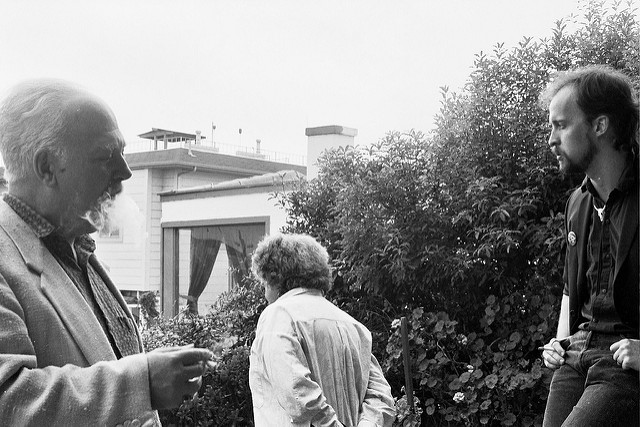
Here’s just one person remembering the group on Erowid a few years back after Elizabeth passed: http://www.changes.org/remembering/nina_hollenberg.html
Funny aside, Bruce Eisner (https://en.wikipedia.org/wiki/Bruce_Eisner) who ran a more formal group called the Island Group, nicknamed the F.O.G. “Friends of Gips” since we were all part of Elizabeth’s extended family. I recall F.O.G. being started in part as an informal alternative to the Island Group. The F.O.G. members had little to no regard for formality or structure.
Here’s another photo of another salon style hangout, upstairs on the deck of the 2nd street complex. On this day we comingled with another slightly more formal group from Stanford (but annoyingly formal) called Millbrook West. A lot of the people pictured were also attendees at a lot of the FOG meetings.
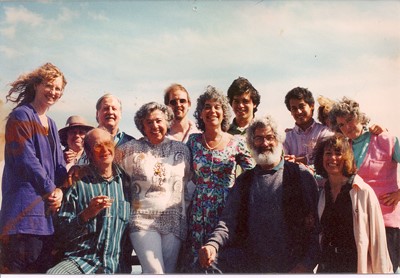
What follows next in Skeptoid’s “analysis” is a lot of unfounded extrapolation that the living room salon group I hung out with in the early 90s is in fact somehow drawn from Parson’s Pasadena “Parsonage” and some place called the Farm which I had no previous knowledge of. (See Skeptoid quote above).
I would point out that none of this speculation is presented in the language of such by Mr. Dunning, but rather presented as a foregone conclusion.
Anyone who has followed my work knows that I have always dedicated my work to the F.O.G. The group dissolved by the early nineties, I had gone off to Silicon Valley to pursue my interests in technology and art, eventually, one by one all the elder members passed on. These people meant a lot to me and my time with them is still one of my fondest memories.
Ong’s Hat Was Not a Game
Skeptoid says:
Some say Matheny was trying to create a game; a type called an Alternate Reality Game, a kind of real-world adventure where people follow a storyline, find clues, and solve puzzles. But there really aren’t any puzzles or solutions in Ong’s Hat. It’s just information, the fabric of a detailed urban legend, which you can choose to believe or not; you can take a deep dive and research thoroughly, or you can laugh it off as a silly story. Either way, Matheny did pull off a feat of cultural engineering by inserting the Ong’s Hat mythology firmly into pop culture.
I reply:
This one is really hard to digest because there is no basis in fact and no real reason why he would make this assertion unless he is simply skimming and half reading things to draw his conclusions. I guess it must be awfully hectic trying to throw a show together every week or whatever his publishing cycle is.
I’ve said it a hundred times or more, I reiterated it in 2001 when I closed the game and I have repeated it multiple times since in print. THIS WAS A LITERARY/GAME HYBRID EXPERIMENT. Therefore, I’ll simply give you these links, rather than continuing to flog a dead horse. If you’re really interested, you can read them or you can repeat the opinion of someone who clearly did not.
The short answer is, many qualified people recognized it as a game because it was a game. It was designed to be a new style of game, one that blended literary style with video and RPG style narrative, and structured, ala, gameplay, to advance the narrative. It also attempted to use an infinite game structure as much as possible, playing for the simple joy of playing, rather than zero-sum game style. I think this is the part that baffled people most. Structure and feature wise, I took a swiss army knife approach and again I recognize that this could confuse some people. However, this approach has allowed it to pivot over time and therefore contributed to its longevity. Just because something isn’t a game as you understand it doesn’t mean it isn’t a game.
Sometimes I think I need to write a book about everything that went on in the background to make this work. Other times I feel like I should just stop trying to explain it to people who have shown no interest in understanding the work on its merits. I meet people all the time who instinctively get what I was attempting. I have also met people who have already made up their minds even in some cases telling me they had “no interest in hearing me out.” Anyway, back on point—
Some examples of people “thinking it was a game”:
Games Magazine, 2013 https://josephmatheny.com/2013/05/16/the-rise-of-the-arg-games-investigates-alternate-reality-games-and-what-the-future-has-in-store-for-the-curious-experiment/
“ With Ong’s Hat, Matheny took the concept of ‘legend tripping’ – that is, the act of venturing to areas of some horrific and supernatural event aIa The Blair Witch Project- and shifted it online. “I set up this mythos, and hid elements of it all over the internet,” he remembers. “There were phone numbers that you could call, and you would get strange voice mail messages; you might even get a call back from one of the characters. Everybody would come at it from a different angle. It was not a zero-sum game. The whole thing was set up to be an infinite play, so different people would get different things out of its persistence.” This element “People who are interested in this kind of experience are interested in working together. It’s what the community calls the ‘collective detective’ scenario,” says Matheny. “One of my influences was also the murder mystery theatre things that they used to do … I think that people like that kind of stuff. They like to feel that the story is crossing the proscenium and they’re immersed in the story -even to the point of being a character in the story. of the experience, with players reassembling the scattered elements of the story in order to determine exactly what it all meant, would go on I think that’s the hook with ARGs.”
Put a pin in the above because it also dovetails into a future point.
The ”gameplay centered around two things. One the eBook and two the Darkplanet forum. The ebook has a lot of built-in rollover states and hidden clickable areas.
Download the ebook, here https://archive.org/details/inc-iso for just one example. Navigate to the page (seen below) and roll your mouse around. You will see some still functioning pop-ups and click states. Even though this ebook was designed in a very early version of Adobe Acrobat, a lot of the effects still somewhat function. Some of these used to lead to pages on Incunabula.org (now retired) with more solves required to move forward. I also used to set up “pop-up” pages on the website that would appear and then mysteriously disappear. Steganography was used on some of the images on the website and many times cryptic messaging was scattered across a fleet of interlinked websites. There were also geocaches, bookcrossings and dead drops. Why am I even explaining this? Oh yeah…
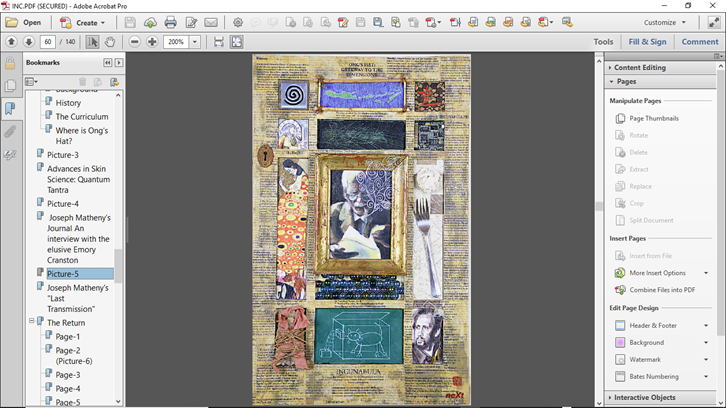
Here’s a quote from Dave Szulborski’s book, This is Not a Game: A Guide to Alternate Reality Gaming https://jmatheny.files.wordpress.com/2014/10/tinagqua.pdf (download the full chapter on Ong’s Hat)
Like any good narrative, the Ong’s Hat story actually intertwined two distinct plots or sequences of events: the events in the Ong’s Hat Ashram in the 1970s that the “Incunabula 83 Papers” allegedly detail, which served as the story level of the narrative, and the discovery and distribution of the documents sometime later, which served as the discourse level of the narrative. So, undeniably, the Ong’s Hat experience had the aesthetic elements of a story required to make an ARG an immersive experience. Additionally, Ong’s Hat: Incunabula, by using the various real-world communication methods available on the Internet at the time to tell its story, and by requiring players to interact at a critical point of the discourse, also incorporated the game elements that traditionally make up and define an alternate reality game. At the very least, like House of Leaves, referenced earlier in this book, it was a literary/digital crossover, utilizing Xerox, BBS and later Internet technology, CD ROM technology, and even traditional print publishing as it’s various mediums. In fact, one of the creators of the original CD ROM has said that it included 23 intricate puzzles, most of which were never solved!
And one more for good measure, although far from the only clear signs of the game and puzzle aspects of Incunabula/Ong’s Hat.
Chronicle of Higher Education review of Legend-Tripping Online: Supernatural Folklore and the Search for Ong’s Hat https://www.chronicle.com/blogs/pageview/the-surprising-online-life-of-legends/29221
In Legend-Tripping Online, he describes how his observations led him to a bizarre Internet phenomenon, the main focus of his book: an “immersive” online experience—part mystery, part game, part who knows what—known as both the Incunabula Papers and Ong’s Hat. Those were the abbreviated titles of documents that someone—probably a group of four provocateurs—posted on The Well, a pioneering Internet social site in the late 1980s.
The Incunabula Papers/Ong’s Hat was, or is, a “many-threaded, open-ended interactive narrative” that ”weds an alternate history of chaos science and consciousness studies to conspiracy theories, parallel dimensions, and claims that computer-mediated environments can serve as magical tools,” Kinsella explains.
Fortunately, he elaborates: After sitting largely dormant on the social Web site for a decade, the documents provoked a widespread “immersive legend-trip” in the late 1990s. Via Web forums, participants investigated the documents—manifestos—which spun up descriptions of brilliant but suppressed discoveries relating to paths that certain scientists had forged into alternate realities. Soon, those haunted dimensions existed in the minds and fantasies of Ong’s Hat’s many participants. That was evident as they responded to the original postings by uploading their own—all manner of reflections and artifacts: personal anecdotes, audio recordings, and videos—to augment what became “a really immersive world, and it was vast,” says Kinsella.
Then there’s the matter of this document which was included in the Original CD ROM (99) of the interactive ebook that was the starting place for the gameplay and which I referenced in the original 2001 game conclusion announcement.
Stick a pin in this as well for our last point.
Rather than continuing to flog a dead horse, I refer you to multiple articles that can be found on my site: https://josephmatheny.com that clearly demonstrate that Ong’s Hat suffered from acute gamification.
I Am Still Being Cryptic About the Origins Behind Ong’s Hat
Skeptoid says:
What does Matheny himself have to say? Well, he’s as cryptic as ever — stating that he’s kind of done talking about it, but he’s not yet giving any hint that he might have made it all up.
I reply:
What follows is a small sampling of the many items prominently highlighted on my site. Does this looks like someone who’s being “cryptic”? I see that Mr. Dunning has a copy of a link to the Salon piece at the bottom of the article on Skeptoid, but I wonder if he actually listened to it? Well, I advise you to and then ask yourself, “Does this sound like a man being coy or cryptic?” Before you say it, the Salon article came out months before the Skeptoid article.
Wikipedia: Ong’s Hat was one of the earliest Internet-based secret history conspiracy theories created as a piece of collaborative fiction (aka Incunabula) by four core individuals, although the membership propagating the tale changed over time.
This Wikipedia entry was not made by me but I have never contested it nor tried to disavow it. It is correct and it has been in place for a very long time. I even link to it from my site, on the opening page.
Decoder Ring: The Incunabula Papers (October 2018- before the pub date of the Skeptoid article) https://slate.com/culture/2018/10/decoder-ring-explores-the-interdimensional-conspiracy-theory-known-as-ongs-hat-the-man-who-created-it-and-the-new-form-of-art-it-birthed.html?via=section_features
Or even more recently, Gizomodo: Ong’s Hat: The Early Internet Conspiracy Game That Got Too Real https://gizmodo.com/ongs-hat-the-early-internet-conspiracy-game-that-got-t-1832229488
Also, see
Chronicle of Higher Education review of Legend-Tripping Online: Supernatural Folklore and the Search for Ong’s Hat https://www.chronicle.com/blogs/pageview/the-surprising-online-life-of-legends/29221
This and Kinsella’s book, published in 2011 is something that I have not only never contested by have actively promoted on this site and others.
Remember when I said to put a pin in this?
“The response of Joseph Matheny to Legend-Tripping Online suggests the success of Kinsella’s read on the Incunabula Papers. On his Web site, Matheny wrote that Kinsella “did an excellent job and only missed the mark with two or three of his conclusions,” which Matheny said he would clear up by writing a complimentary account.”
Read the rest at your own leisure and tell me, does me promoting these items sound like someone who is being “cryptic?
Games Magazine, 2013 https://jmatheny.files.wordpress.com/2013/05/games-arg1.pdf Remember when I said t put a pin in this?
“I set up this mythos, and hid elements of it all over the internet,” he remembers. “There were phone numbers that you could call and you would get strange voice mail messages; you might even get a call back from one of the characters. Everybody would come at it from a different angle. It was not a zero-sum game. The whole thing was set up to be an infinite play, so different people would get different things out of its persistence.” This element “People who are interested in this kind of experience are interested in working together. It’s what the community calls the ‘collective detective’ scenario,” says Matheny. “One of my influences was also the murder mystery theatre things that they used to do … I think that people like that kind of stuff. They like to feel that the story is crossing the proscenium and they’re immersed in the story -even to the point of being a character in the story. of the experience, with players reassembling the scattered elements of the story in order to determine exactly what it all meant, would go on I think that’s the hook with ARGs.”
That should be pretty self-explanatory,
A few more for the road.
- http://knowyourmeme.com/memes/subcultures/alternate-reality-games
- https://youtu.be/siF75w1gJrA
- https://slate.com/culture/2018/10/decoder-ring-explores-the-interdimensional-conspiracy-theory-known-as-ongs-hat-the-man-who-created-it-and-the-new-form-of-art-it-birthed.html?via=section_features
- https://jmatheny.files.wordpress.com/2008/10/mk.pdf (1995)
Yes, I already hear the objections but check the dates of those articles. ALL of them precede the publication date of the Skeptoid article, with the exception of the Gizmodo piece.
My Conclusions Regarding Brian Dunning and The Skeptoid Podcast
All in all, if I were a fan of Skeptoid I would unpack a few episodes besides this one and see if Brian is on point with other of his self proclaimed “Skeptoid style investigations”. I mean, after all, he is encouraging us to be skeptics, right? I see from a simple search that this isn’t his first error or even his second or– well you get the point. One can only hope he is a sincere actor and learns from and admit to his errors.
As I said before, be careful who you allow as the curator of your “truths” on the Internet Because after all, it is 2019 and it is the Internet.
One of the things I always wanted to do in 2001, post-Incunabula/Ong’s Hat was host to a conversation about what’s real and how perception can be weaponized and used against you. I was not allowed to do this mainly because the conspiranoia crowd had such a violent reaction to my “admission” that a far-out story like Ong’s Hat was actually a modern Borgesian fairy tale. Too bad, because considering all the things that followed, like Pizzagate and Q-Anon, that may have been a useful conversation to have had that early in the process. That part of it was always intended as an act of closure, it just never happened due to irrational hysteria that shouted down any attempt.
I fully support the stated mission statement of Skeptoid but at least, in this case, it seems they do not really live up to the promise.
In conclusion, I’ll remind you, gentle reader, be a critical thinker, be a skeptic, by all means, but please, if you’re going to critique something, take the time to actually read and/or listen to the material you are critiquing. Otherwise, your critique is neither a critique nor is it skeptical inquiry. It is merely dismissive opinion and frankly, looks like click-bait.
It’s fine to be critical and skeptical of someone’s work. Just do so based on the facts and not based on supposition or a pre-constructed narrative or heaven forfend, on incomplete research and therefore, misinformation.
Be well and stay safe. Lots of mind virii are afloat these days. Always remember to wear the cognitive condom of critical thinking and always, TFYQA.
ALSO, SEE-
BRIAN DUNNING ON THE JOE ROGAN EXPERIENCE: A MASTERCLASS IN BAD SKEPTICISM
The Worst Thing Brian Dunning Has Done for Skepticism
Joe Rogan and Brian on Twitter
Brian’s “Shell Game”?
Some of Brian’s “Greatest Hits”
Skeptoid’s Dunning: The Story of a Man Who Hoodwinks Unskeptical Skeptics*


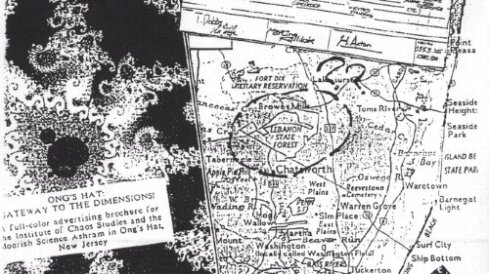
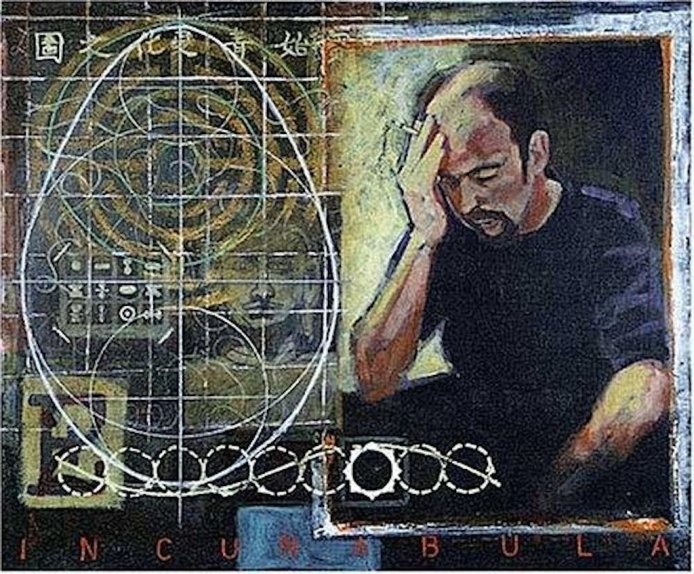
One Reply to “Corrections to Brian Dunning’s Skeptoid Podcast About Ong’s Hat”